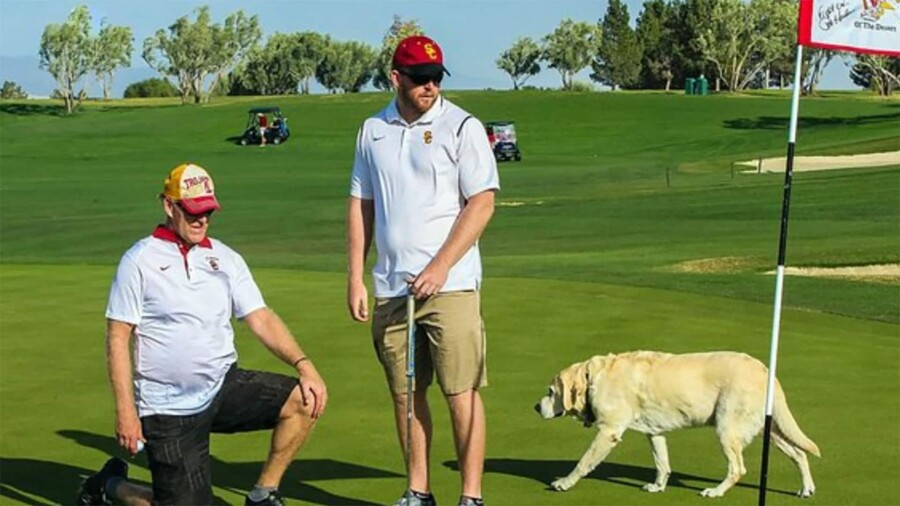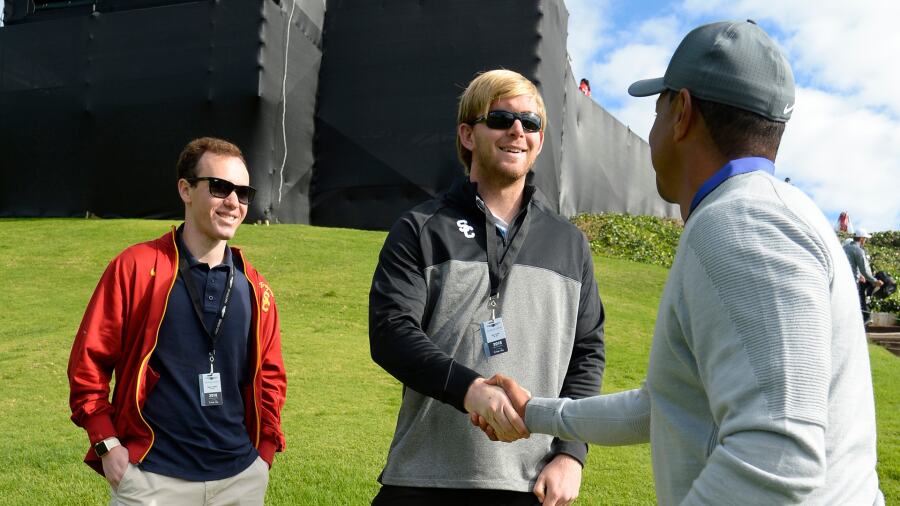Jake Olson was a sophomore in high school when he received an opportunity to play Pebble Beach Golf Links with two-time Masters champion Ben Crenshaw. After Olson knocked a wedge to 18 feet at the oceanside resort’s iconic par-3 seventh hole, Crenshaw surprised Olson by handing him his famous Wilson 8802 putter, nicknamed “Little Ben,” to hit the birdie putt.
“And I actually made it,” Olson said.
That wouldn’t be Olson’s last brush with history.
A few years later, as a walk-on long snapper at USC, Olson snapped for a successful PAT attempt in the Trojans’ 2017 season opener against Western Michigan, becoming the first blind athlete to play in an NCAA Division I football game.
Now, Olson, a 25-year-old from Huntington Beach, California, is set to take part in another first: the inaugural U.S. Adaptive Open, which begins Monday at Pinehurst No. 6. The 54-hole event, which welcomes 96 competitors to the North Carolina golf mecca, was created to showcase the world’s best golfers with disabilities.
Olson, who is among those playing out of the visually impaired category, will compete against golfers, both male and female, with a variety of impairments: arms, legs, intellectual and neurological. Other categories include multiple limb amputees, seated players and players of short stature.
“It’s such an honor to be a part of this,” Olson told GolfChannel.com ahead of the historic championship. “I’m so proud of the USGA for doing this and recognizing the play of a population that really, I think, represents the game well. It’s just an incredible feat to play such a frustrating, difficult game with some of the disadvantages that we face, and I think that should absolutely be showcased and highlighted.”
Olson was diagnosed with retinoblastoma, an eye cancer that develops in the retina, when he was 8 months old and lost his left eye. For nine years, Olson underwent countless treatments, from radiation to chemotherapy, on his right eye, though he still enjoyed his passions, most notably football and golf.
The latter Olson had just decided to take more seriously when, in November 2009, the cancer forced doctors to remove Olson’s remaining eye.
“Obviously, that was a big roadblock in the new goal I had just created,” Olson said. “But one of my overarching goals was that blindness wasn’t going to stop me from the things I love and the goals I had set for myself, and that included playing golf, so that was one of the things that we really attacked after I lost my eyesight was my ability to play the game of golf still.
“So, we went to work, and it was definitely a lot of work.”
First, Olson had to learn to make consistent and solid contact despite not being able to see the ball. That took a few years. He also had to find a way to navigate a golf course. That’s where his guide dog, a yellow lab named Quebec, and his father, Brian, play roles.
Quebec is the perfect playing partner. “His favorite place on the planet is the golf course,” Jake says. “I’ve played hundreds of rounds with him.” (Unfortunately, because of the high temperatures expected at Pinehurst, Quebec did not make the trip to North Carolina.)
Brian Olson is his son’s eyes. Before every shot, he goes over each detail with Jake, from adjusted yardages to hole locations to potential hazards (Jakes tells a story of the time his mother, Cindy, caddied for him and forgot to alert him of a greenside bunker between he and the hole; he ended up chipping right into the trap). Once the Olson duo gathers all of its information and selects a club, Jake will hold the club out and Brian will position the face behind the ball as Jake takes his stance.
Then, like all golfers, Jake focuses on making a good swing.
“It’s complex yet simple at the same time … like golf itself,” Brian Olson told Fore Magazine in 2018. “It’s not just getting the club set up for him, it’s helping him really feel and sense how it’s happening and the shot he wants to hit. Early on, it was like trying to brush your teeth with your left hand. It took some time to perfect.”
Jake describes his re-learning of the game as “100 steps forward and 90 steps back.” It didn’t help, of course, that he grew about 7 inches during that period, which demanded a substantial – and continuous – overhaul of his swing.
“We’d make a change in my swing, and I’d start missing the ball again, and it was just so frustrating to have all that progress wiped away,” he recalls.
Still, Olson kept persevering. Through the whiffs. Through the disaster holes. Through the embarrassment. Olson’s courage never wavered; he just needed to gain the confidence that despite his blindness, he could still play the game competitively.
Olson will never forget the feeling of completing his first hole, unscathed, after his surgery.
“That was a big thing,” he says.
By his junior year, Olson was shooting in the 80s and had made the varsity golf team at Orange Lutheran High School in Orange, California, where he also played football. He then enrolled at USC, his dream school and where six years earlier he had been welcomed into the Trojans’ football family and made an honorary member of the team by former head coach Pete Carroll.
Olson still considers that gesture crucial in giving him that initial hope to chase his dreams. And to this day, Olson continues to pay it forward. During his senior year, he turned USC’s pro day into a fundraising campaign to help back research for a promising retinoblastoma treatment.
“It gives me chills right now, just thinking I could come back 10 years later and help aide the treatment [for the cancer] that took my eyesight,” Olson told ESPN.com in 2019. “It gave me goosebumps when I first heard about it because I’m just like, ‘Wow, we’re at this pivotal moment right now.’”
Upon graduating with his bachelor’s degree in business, Olson was one of six co-founders of Engage, an online talent-booking service with an impressive stable of available speakers, including Olson, who makes appearances and gives motivational speeches across the country. (Olson is also a published author.)
This week, however, Olson will let his golf clubs do most of the talking.
Though he’s no Tiger Woods, a nine-time USGA champ who not only wrote Olson a congratulatory letter after his historic snap but later met and talked with Olson at that next year’s Genesis Invitational, Olson is no stranger to national championships. He won the 2019 U.S. Blind Golf Association National Championship at Las Vegas Golf Club, where he, as a 16-handicap, shot 95-86, closing with a final-nine 38 that included a triple bogey.
Olson, who now plays to a 10, would love to add to his trophy case and put his name in another history book. But then again, if he’s been taught anything, it’s to maintain the proper perspective.
This week isn’t about winning so much as it is about inspiring others.
“It will be surreal being out there, knowing what it means to be in the first inaugural championship as well as playing against others who are battling their own challenges,” said Olson, who begins his tournament at 10 a.m. ET Monday playing alongside Brian Bemis (leg impairment), Kurtis Barkley (short stature) and Kellie Valentine (arm impairment). “That’s really what the real importance of this is, showcasing to the world and families and kids who are dealing with maybe blindness or whatever kind of adversity, and giving hope and inspiration to those who maybe feel like they had to forfeit on their love for the game of golf or football or whatever sport they played or whatever they want to do in life.
“It’s like, hey, let’s find a way. You have that will, you have that passion, let’s just find a way. It’s doable, it’s possible.”
Olson, and the rest of the golfers converging on Pinehurst No. 6 this week, are proof.





